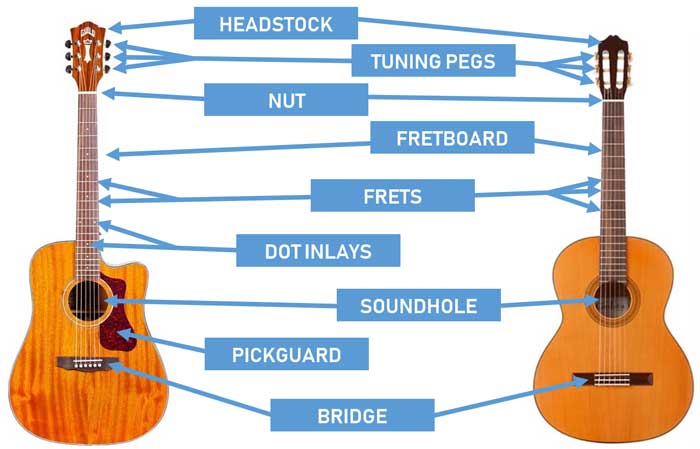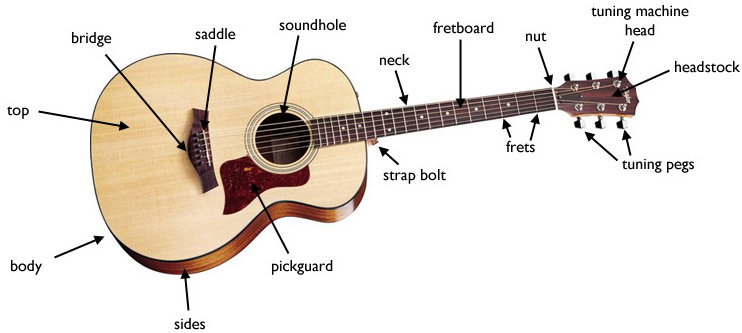

The pick guard serves as protection to the finish and the wood top of the body while a player strums over the lifetime of the guitar. When the strings are strummed on an acoustic guitar, the vibration is focused chiefly to the top (surface) of the guitar body, as the rest of the body causes amplification and projection through the sound hole. The saddle is essential such that without it, the vibration of the strings would not transfer to the body very well for amplification. The strings are taut over the saddle and are anchored by pins through holes that are housed in the bridge. Guitars belong to a class of instruments called chordophones (in the same family as banjos, pianos and dulcimers) and their most universal identifying characteristic is that they create sound when a string that is taut between two point is caused to vibrate. The basis of the body of the guitar is to amplify the sound of the strings in an acoustic guitar, as well as provide a decent amount of placement for holding the guitar and the other end of the strings. The Body Region is where a lot of other magic happens. They are not as important for a brand new player, but will prove more helpful when one learns to play bar chords and more advanced scales and improvisations. Those dots mark specific frets for quick reference for the beginner or advanced guitar player. On the fretboard are several dots that are specifically placed there as references. The fretboard extends to the body, beyond the neck and heel of the guitar, ending at the sound hole. Chording can take place virtually anywhere on this fretboard, but must follow some specifics to get an actual musical chord. On top of the neck surface is the actual fretboard as discussed in the previous paragraph. The purpose of the fretboard (and the bars between the frets) is to create a temporary “endpoint” other than the “nut”, thereby changing the length of the string and increasing it’s pitch or frequency. There are two ways to change the pitch of a string essentially: by changing the tension (tightening or loosening ~ or in more advanced studies, by bending it) or by changing the length of the string. For the right handed player, the left hand fingers are used for chording and for the left-handed player, the right hand is the chording hand. For many players, this is where the fingers of the chording hand press the strings into the frets to shorten the “nut” end of the string, thereby giving the string a different pitch. The Neck Region is where a lot of the action takes place.

The nut keeps the strings equally spaced at the head / neck end and allows the strings to vibrate freely when open or not chorded. If you tighten the string, it will increase the pitch or frequency of the string (making the note higher), and if you loosen the string with the tuners, it will decrease the pitch or frequency when the string is strummed, picked or plucked.Īt the bottom of the head (and arguably the top of the neck) is a block of plastic or other hard material called the nut.

One end of each of the 6 strings (on a 6 string guitar) is wound about the machine head which in turn is geared by the tuning keys or tuners. The Head Region or Headstock is where the “tuning” of the strings takes place. It’s true that a more advanced player may use more of the fretboard, but the parts that comprise a guitar are universal. The Acoustic guitar anatomy or layout is essentially the same for the beginner and the advanced player alike. The Acoustic Guitar, 3 Regions, Many Parts! In the event that you ever take lessons or talk to other players, you will be able to communicate and learn more appropriately.
#The parts of the guitar how to
Before learning how to play an acoustic guitar, it is beneficial for a beginner acoustic guitar player to learn the part of a guitar.


 0 kommentar(er)
0 kommentar(er)
